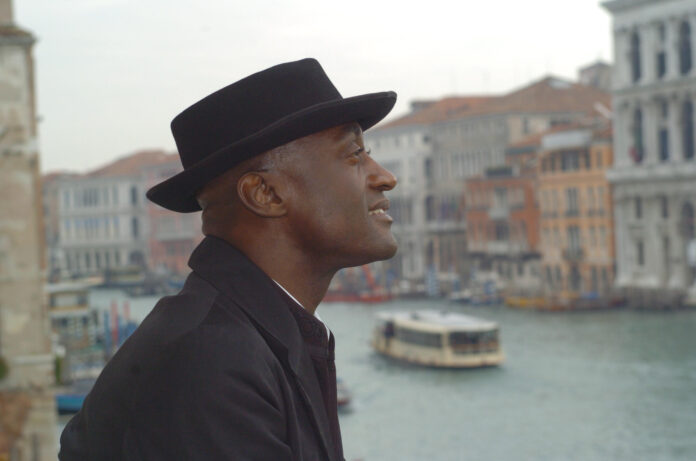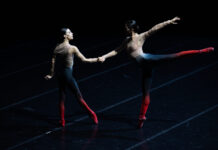The Moro of Venezia
Ismael Ivo, an Afro-descendant, born in Sao Paulo in Brazil in 1955, was a performer of incisive presence and beauty, multi-ethnic choreographer, and tireless activist of body art. He was director of the Venice Biennale Danza for eight years. It is too easy to think of him as a resplendent Shakespearean “Moro of Venice”. He landed in the Lagoon with solo Mapplethorpe in 2002, invited by Carolyn Carlson in the “Solo Men” billboard. Three years later he was called to head the festival and college dance activities. Since then he tirelessly conceived several tours around the world, choosing a programmatic title for each edition: Body Attack (2005), Under Skin (2006), Body & Eros (2007), Beauty (2008), Grado Zero (2009), Capturing Emotions (2010), Body in Progress + Moving the City (2011) and Awakening (2012).
The body as document of today
This enthusiastic agit-prop recently died of Covid in his hometown. So that, Wayne McGregor, who is now the new dance director, wanted to dedicate an exhibition to him with the title The Body as a document of today. The words of the title are taken from an interview with Ismael Ivo right at the Arsenale in Venice, a tribute that opens the 2021 festival. Ismael Ivo was an animator, a stirrer, an educator Moreover, he has signed several “multicultural” works for the young artists of the Arsenale della Danza: Erendira, Illuminata, Oxygen, Babilonia. The third Paradise, The Waste Land, Library of the body.
Ismael Ivo among Wien, Berlin, and Sao Paulo
However, before and after Venice, he had a high standard career. Starting from Brazil, strengthened only by his vocation and experience in local dance, he had his first significant experience in 1983, in Alvin Ailey’s magnificent New York African American forge. Then, arriving in a cosmopolitan and welcoming Berlin, he worked with Johann Kresnik, the most political choreographer of the German Tanztheater, and with Ushio Amagatsu, leader of the refined Japanese modern male group Sankai Juku.
Then in 1984, with Karl Regensburger, founder of the Viennese International Tanzwochen, ImPulsTanz became one of the major European dance events. For fifteen years he had been an artistic consultant, a friend of all the greatest contemporary artists. In the German-speaking area he had found success and creative stimuli, collaborating, as an interpreter, with George Tabori, Marcia Haydée, Brazilian star and director of the Stuttgart Ballett, Yoshi Oida and Koffi Koko, including Tanztheater, Japanese Butoh and dance of African roots.
He then returned to Brazil and since 2017 he was at the head of the Balé da Cidade de São Paulo. An exemplary journey across multiple continents, multiple styles, multiple civilizations.
You can also read:
African dance and around – Arte africana e dintorni
Il Moro di Venezia
Ismael Ivo, afrodiscendente, nato a San Paolo in Brasile nel 1955, performer di presenza e bellezza incisive, coreografo multietnico e instancabile attivista dell’arte del corpo, è stato per otto anni direttore della Biennale Danza di Venezia. Fin troppo facile pensare a lui come a uno shakespeariano splendente “Moro di Venezia”.
Approdato in Laguna con il solo Mapplethorpe nel 2002, invitato da Carolyn Carlson nel cartellone di “Solo Men”, fu poi chiamato alla testa delle attività di festival e di college per la danza tre anni dopo. Da allora ideò instancabilmente diversi giri intorno al mondo, scegliendo per ogni edizione un titolo programmatico: Body Attack (2205), Under Skin (2006), Body & Eros (2007), Beauty (2008), Grado Zero (2009), Capturing Emotions (2010), Body in Progress + Moving the City (2011) e Awakening (2012).
Il corpo è un documento dell’oggi
A questo entusiasta agit-prop, da poco scomparso per Covid nella sua città natale, Wayne McGregor, che da quest’anno gli è succeduto nella posizione di direttore della danza, ha voluto dedicare una mostra. Essa è intitolata con le parole tratte da un’intervista a Ismael Ivo proprio all’Arsenale di Venezia, Il corpo è un documento dell’oggi/The Body as a document of today, un tributo che apre il festival 2021.
Ismael Ivo è stato un animatore, un suscitatore, un educatore; e per i giovani artisti dell’Arsenale della Danza ha firmato più lavori “multiculturali”: Erendira, Illuminata, Oxygen, Babilonia. Il terzo Paradiso, The Waste Land, Biblioteca del corpo.
Ismael Ivo tra Vienna, Berlino e San Paolo
Ma prima e dopo Venezia, la sua è stata una carriera di alto standard. A partire dal Brasile, forte solo della sua vocazione e di un’esperienza nella danza locale, ebbe la prima significativa esperienza nel 1983, nella magnifica fucina afro-americana newyorkese di Alvin Ailey. Approdato, poi, in una Berlino cosmopolita e accogliente, ha lavorato con Johann Kresnik, il coreografo più politico del Tanztheater tedesco, e con Ushio Amagatsu, guida del raffinato gruppo maschile di danza moderna nipponica Sankai Juku.
È divenuto poi nel 1984 con Karl Regensburger fondatore dell’International Tanzwochen viennese, ImPulsTanz, una delle maggiori manifestazioni coreutiche europee. Per quindici anni ne era stato poi consulente artistico, amico di tutti i più grandi artisti contemporanei. In area germanofona aveva trovato successo e stimoli creativi, collaborando, come interprete, con George Tabori, Marcia Haydée, stella brasiliana e direttrice dello Stuttgart Ballett, Yoshi Oida e Koffi Koko, tra Tanztheater, Butoh giapponese e danza di radice africana.
Era poi tornato in Brasile e dal 2017 aveva operato alla testa del Balé da Cidade de São Paulo. Un percorso esemplare tra più continenti, più stili, più civilizzazioni.








